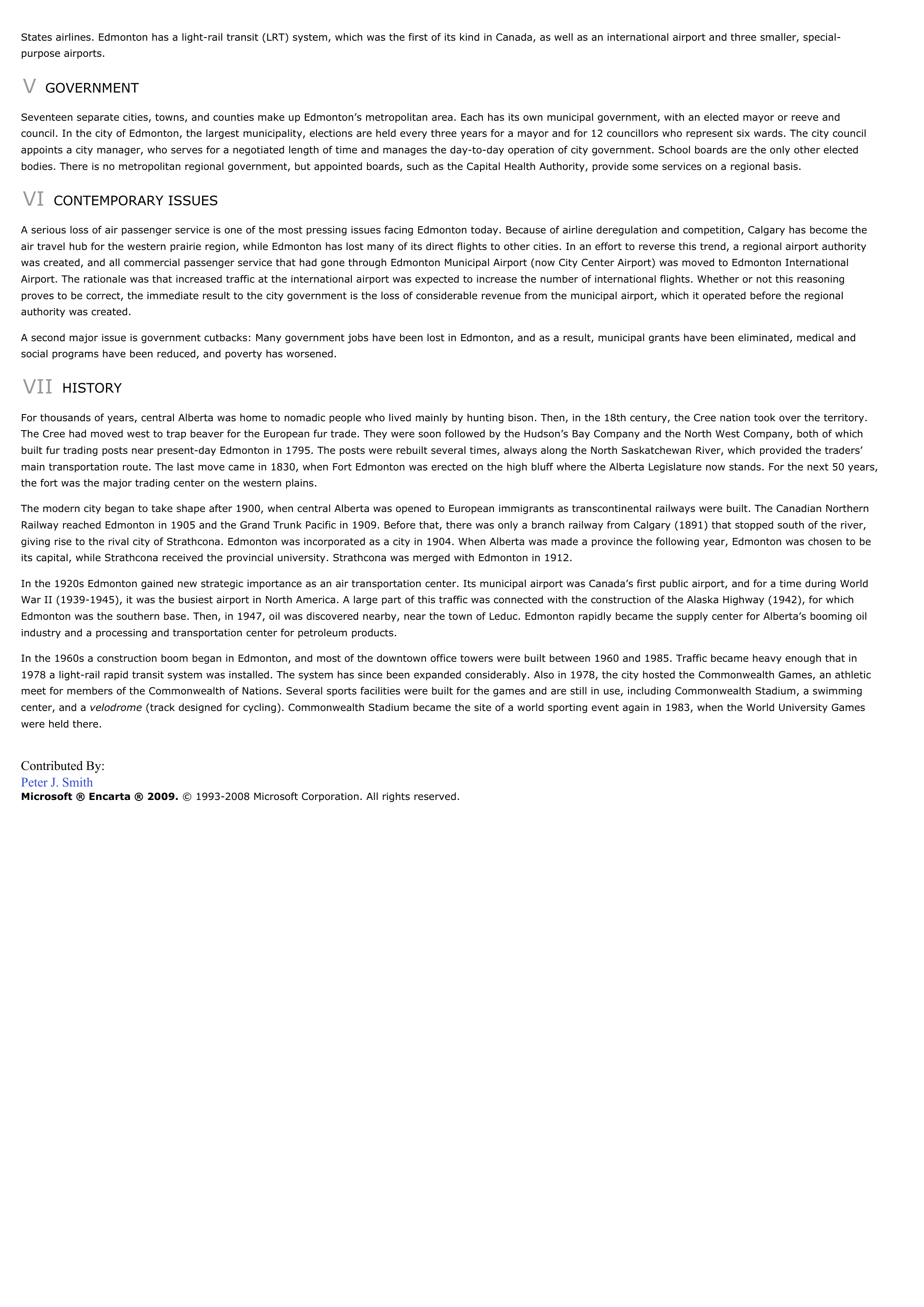Edmonton - geography.
Publié le 26/05/2013
Extrait du document
«
States airlines.
Edmonton has a light-rail transit (LRT) system, which was the first of its kind in Canada, as well as an international airport and three smaller, special-purpose airports.
V GOVERNMENT
Seventeen separate cities, towns, and counties make up Edmonton’s metropolitan area.
Each has its own municipal government, with an elected mayor or reeve andcouncil.
In the city of Edmonton, the largest municipality, elections are held every three years for a mayor and for 12 councillors who represent six wards.
The city councilappoints a city manager, who serves for a negotiated length of time and manages the day-to-day operation of city government.
School boards are the only other electedbodies.
There is no metropolitan regional government, but appointed boards, such as the Capital Health Authority, provide some services on a regional basis.
VI CONTEMPORARY ISSUES
A serious loss of air passenger service is one of the most pressing issues facing Edmonton today.
Because of airline deregulation and competition, Calgary has become theair travel hub for the western prairie region, while Edmonton has lost many of its direct flights to other cities.
In an effort to reverse this trend, a regional airport authoritywas created, and all commercial passenger service that had gone through Edmonton Municipal Airport (now City Center Airport) was moved to Edmonton InternationalAirport.
The rationale was that increased traffic at the international airport was expected to increase the number of international flights.
Whether or not this reasoningproves to be correct, the immediate result to the city government is the loss of considerable revenue from the municipal airport, which it operated before the regionalauthority was created.
A second major issue is government cutbacks: Many government jobs have been lost in Edmonton, and as a result, municipal grants have been eliminated, medical andsocial programs have been reduced, and poverty has worsened.
VII HISTORY
For thousands of years, central Alberta was home to nomadic people who lived mainly by hunting bison.
Then, in the 18th century, the Cree nation took over the territory.The Cree had moved west to trap beaver for the European fur trade.
They were soon followed by the Hudson’s Bay Company and the North West Company, both of whichbuilt fur trading posts near present-day Edmonton in 1795.
The posts were rebuilt several times, always along the North Saskatchewan River, which provided the traders’main transportation route.
The last move came in 1830, when Fort Edmonton was erected on the high bluff where the Alberta Legislature now stands.
For the next 50 years,the fort was the major trading center on the western plains.
The modern city began to take shape after 1900, when central Alberta was opened to European immigrants as transcontinental railways were built.
The Canadian NorthernRailway reached Edmonton in 1905 and the Grand Trunk Pacific in 1909.
Before that, there was only a branch railway from Calgary (1891) that stopped south of the river,giving rise to the rival city of Strathcona.
Edmonton was incorporated as a city in 1904.
When Alberta was made a province the following year, Edmonton was chosen to beits capital, while Strathcona received the provincial university.
Strathcona was merged with Edmonton in 1912.
In the 1920s Edmonton gained new strategic importance as an air transportation center.
Its municipal airport was Canada’s first public airport, and for a time during WorldWar II (1939-1945), it was the busiest airport in North America.
A large part of this traffic was connected with the construction of the Alaska Highway (1942), for whichEdmonton was the southern base.
Then, in 1947, oil was discovered nearby, near the town of Leduc.
Edmonton rapidly became the supply center for Alberta’s booming oilindustry and a processing and transportation center for petroleum products.
In the 1960s a construction boom began in Edmonton, and most of the downtown office towers were built between 1960 and 1985.
Traffic became heavy enough that in1978 a light-rail rapid transit system was installed.
The system has since been expanded considerably.
Also in 1978, the city hosted the Commonwealth Games, an athleticmeet for members of the Commonwealth of Nations.
Several sports facilities were built for the games and are still in use, including Commonwealth Stadium, a swimmingcenter, and a velodrome (track designed for cycling).
Commonwealth Stadium became the site of a world sporting event again in 1983, when the World University Games were held there.
Contributed By:Peter J.
SmithMicrosoft ® Encarta ® 2009. © 1993-2008 Microsoft Corporation.
All rights reserved..
»
↓↓↓ APERÇU DU DOCUMENT ↓↓↓
Liens utiles
- Edmonton - Geography.
- Taylor Brook , 1685-1731, né à Edmonton (Middlesex), mathématicien anglais.
- McLuhan Herbert Marshall , 1911-1980, né à Edmonton (Alberta), sociologue américain.
- Edmonton.
- Tokyo - geography.

































